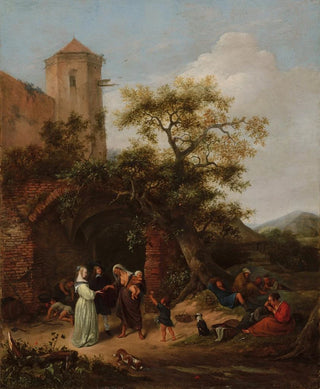Art print | The fortune-teller - Jan Steen Source: Reproduction | La diseuse de bonne aventure - Jan Steen


View from behind

Frame (optional)
In the vibrant world of Dutch baroque art, the art print "La diseuse de bonne aventure" by Jan Steen stands out for its liveliness and boldness. This emblematic scene, where mystery and everyday life intertwine, invites the viewer to immerse themselves in a moment of life where superstition and illusion are intertwined. Steen, master of pictorial storytelling, captures with finesse the moment when a young woman, both charming and enigmatic, reveals the future to a man who is visibly intrigued. The composition, rich in detail and emotion, transports us into an atmosphere that is both intimate and dramatic, revealing the subtleties of human relationships through the lens of belief and curiosity.
Style and uniqueness of the work
"The art print" is characterized by a vibrant style, typical of Jan Steen, where humor and morality coexist. The color palette, bright and warm, gives the scene an almost lively atmosphere, while the expressions of the characters, ranging from wonder to suspicion, add psychological depth to the piece. The meticulous details, such as everyday objects arranged around the protagonists, enhance the authenticity of the scene. Steen excels in the art of capturing human emotions, and this work is no exception. Every gaze, every gesture, tells a story, inviting the viewer to question the motivations and desires of the characters. The way light illuminates the faces and objects creates a fascinating dynamic, immersing the viewer in a reflection on destiny and free will.
The artist and his influence
Jan Steen, born in 1626, is one of the most emblematic artists of the Dutch Golden Age. His career, marked by success, demonstrates exceptional mastery in depicting everyday life, often tinged with biting irony. Steen draws inspiration from the life around him, painting genre scenes that reveal the customs and vices of his time. His influence is undeniable, both on his contemporaries and on subsequent generations of artists. Using the painting as a mirror

Matte finish

View from behind

Frame (optional)
In the vibrant world of Dutch baroque art, the art print "La diseuse de bonne aventure" by Jan Steen stands out for its liveliness and boldness. This emblematic scene, where mystery and everyday life intertwine, invites the viewer to immerse themselves in a moment of life where superstition and illusion are intertwined. Steen, master of pictorial storytelling, captures with finesse the moment when a young woman, both charming and enigmatic, reveals the future to a man who is visibly intrigued. The composition, rich in detail and emotion, transports us into an atmosphere that is both intimate and dramatic, revealing the subtleties of human relationships through the lens of belief and curiosity.
Style and uniqueness of the work
"The art print" is characterized by a vibrant style, typical of Jan Steen, where humor and morality coexist. The color palette, bright and warm, gives the scene an almost lively atmosphere, while the expressions of the characters, ranging from wonder to suspicion, add psychological depth to the piece. The meticulous details, such as everyday objects arranged around the protagonists, enhance the authenticity of the scene. Steen excels in the art of capturing human emotions, and this work is no exception. Every gaze, every gesture, tells a story, inviting the viewer to question the motivations and desires of the characters. The way light illuminates the faces and objects creates a fascinating dynamic, immersing the viewer in a reflection on destiny and free will.
The artist and his influence
Jan Steen, born in 1626, is one of the most emblematic artists of the Dutch Golden Age. His career, marked by success, demonstrates exceptional mastery in depicting everyday life, often tinged with biting irony. Steen draws inspiration from the life around him, painting genre scenes that reveal the customs and vices of his time. His influence is undeniable, both on his contemporaries and on subsequent generations of artists. Using the painting as a mirror






